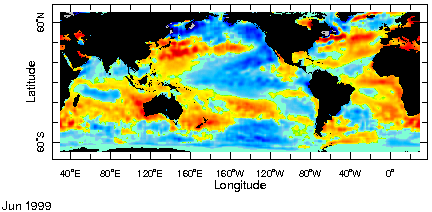
| ||||
IRI Climate Information Digest - June 1999Issued 13 July 1999
Precipitation June rainfall anomalies associated with the on-going La Nina include drier than normal conditions in the central equatorial Pacific and higher than average rainfall in the west Pacific. Summer monsoon rains are underway in several regions of the world. In India accumulated rainfall exceeded average amounts through the end of June. In west Africa, the coast along the Gulf of Guinea has received abundant rainfall in the regions where warm Atlantic waters are present, while the the rainy season in the Sahel has had a slow start with early reports of below average rainfall. The North American monsoon has begun with much needed rainfall for northern Mexico. Drier than average conditions have evolved in the eastern seaboard of the United States. Below average rainfall has continued in Chile.
Temperature Above average temperatures
have dominated Africa, and much of Europe, the Middle East and China. Warm
temperatures have also prevailed in Brasil and Chile associated with the
dry regions there. Northeastern North America has experienced above average
temperatures associated with very dry conditions. The only major land area
experiencing below average temperatures in June was Russia, east of the
Ural Mountians. The relatively cool west coast of North America is influenced
by colder than normal temperatures in the Pacific. Forecasts - Seasonal Temperature and Precipitation Impacts - On Fisheries, Agriculture, Health and Hazards.
|

